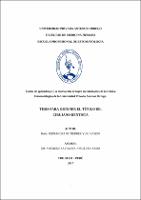Estilos de aprendizaje y la motivación de logro en estudiantes de la Clínica Estomatológica de la Universidad Privada Antenor Orrego

Ver/
Descargar
(application/pdf: 872.1Kb)
(application/pdf: 872.1Kb)
Fecha
2017Autor(es)
Fernandez Gutierrez, Yuli Yaseni
Metadatos
Mostrar el registro completo del ítemResumen
El presente trabajo de investigación de tipo descriptivo correlacional tuvo como objetivo
relacionar los estilos de aprendizaje y la motivación de logro en los estudiantes de la
clínica estomatológica de la Universidad Privada Antenor Orrego.
La muestra estuvo conformada por la población total de alumnos de la clínica
estomatológica se seleccionó por el método no probabilístico por conveniencia a los
alumnos que cumplan con los criterios de inclusión y exclusión.
Para la recolección de información del estudio se tuvo en cuenta dos inventarios: test de
estilos de aprendizaje de David Kold e inventario de motivación de logro de Luis Vicuña
Peri.
Los porcentajes obtenidos que el 28.3% presentan un Estilo Acomodador; con este mismo
porcentaje presentan un estilo de aprendizaje Asimilador, mientras que el 23.9% de los
estudiantes tienen un estilo convergente y el 19.5% un estilo Divergente.La mayoría de
estudiantes tienen un nivel de motivación al logro en el nivel Muy Alto, ninguno en el
nivel Bajo y ninguno e el nivel Muy Bajo; solo el 4.4% se ubicaron en el nivel Alto;
mientras que el 39.1% tienen un nivel de Tendencia al Alto; y también el 56.5% presentan
un nivel de motivación al logro de Tendencia a Bajo.
En los resultados obtenidos de los estudiantes referentes al sexo (femenino y masculino)
de los estilos de aprendizaje y el nivel de motivación de logro demostró que no son
influenciados entre sí.Demostrándose que no existe ninguna relación entre los estilos de
aprendizaje y la motivación de logro. Más si se puede encontrar cierta tendencia frente a
otras estrategias. The present study of descriptive correlational research aimed to relate the learning styles
and motivation of achievement in the students of the Stomatological Clinic of the Private
University Antenor Orrego.
The sample consisted of the total population of students of the stomatologic clinic was
selected by the non-probabilistic method for convenience to the students that meet the
inclusion and elimination criteria.
For the collection of information from the study, two inventories were taken into account:
David Kold's learning style test and Luis Vicuña Peri achievement motivation inventory.
The percentages obtained that the 28.3% present a Style Accommodation; With this same
percentage they present an assimilating learning style, while 23.9% of the students have
a convergent style and 19.5% a Divergent style.
Most students have a level of motivation to achieve at the Very High level, none at the
Low level and none at the Very Low level; Only 4.4% were in the High level; While
39.1% have an upward trend; And also 56.5% have a level of motivation to achieve
Tendency to Low.
In the results obtained from the students regarding the sex (female and male) of the
learning styles and the level of achievement motivation demonstrated that they are not
influenced with each other.
By demonstrating that there is no relationship between learning styles and achievement
motivation. More if you can find a certain trend compared to other strategies.
Palabras clave
Colecciones
- Estomatología [687]

